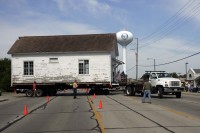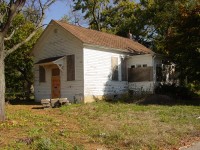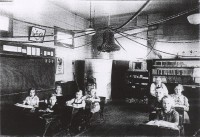 A 20- by 36-foot, 22-ton historical building in the town of Algonquin, Illinois was moved a quarter-mile down the road to the village of Lake in the Hills today. Built in 1886 on the Lucy B. Ford Farm in what is now Lake in the Hills, the school had no indoor plumbing and just one room where up to 26 children in first through eighth grades were taught together.
A 20- by 36-foot, 22-ton historical building in the town of Algonquin, Illinois was moved a quarter-mile down the road to the village of Lake in the Hills today. Built in 1886 on the Lucy B. Ford Farm in what is now Lake in the Hills, the school had no indoor plumbing and just one room where up to 26 children in first through eighth grades were taught together.
Watching the painstakingly slow movement of the schoolhouse were three Lake in the Hills residents with a particular connection to Ford School: two former students — Albert Ebel Friday (94) and his sister Eunice Andreas (98) — and Duane Andreas (78), the son of Eunice and her husband Weldon Andreas, the last teacher Ford School ever had. People watching the move crowded around them to listen to them reminisce about the old times.
Duane said his dad, the schoolteacher, would take him to Ford School when he was just 4 or 5 so he could see what it was like. At the time, there were only eight kids and it was OK to have a little kid watching them.
“It’s so different now,” he said. Back then, students would listen to the lesson of each grade, and become exposed to higher learning at younger ages, Duane said. “People, they helped each other,” he said. It was a nicer time then, there was no need to compete for the highest grade, or the best classroom scores, he said. The children helped each other succeed.
Eunice was proud of her spelling skills then. She had 100 perfect spelling lessons. “First time they had a spelling bee in McHenry, I won the first time,” she said.
Albert joked about playing hooky and swimming instead. It was just kids being kids. “You were allowed to raise a little hell, people would look the other way,” Duane noted. “Everyone (now) is so afraid of getting in trouble.”
The school closed in 1939 with the advent of graded education. After World War II, a development company bought 800 acres in the area to create a community of affordable housing for returning GIs, and the schoolhouse was slated for demolition. It was saved from that dire fate by George Sticklemeyer, a farmer down the road who in 1945 bought the building for $250 and moved it to his land. He added a kitchen and bathroom and used it as a bunkhouse for migrant workers.
 In 1960 it was purchased along with various outbuildings and used as a home. In 2003 the land and buildings were sold again to Stonegate Nursery, a landscaping and plant nursery business. The schoolhouse was used as an office. The nursery went out of business three or so years ago, leaving the schoolhouse and six other outbuildings vacant targets for vandals and thieves. By 2011, the property owner had demolished the other outbuildings, but she knew the schoolhouse was historically significant so she just boarded up the windows hoping that it could be saved.
In 1960 it was purchased along with various outbuildings and used as a home. In 2003 the land and buildings were sold again to Stonegate Nursery, a landscaping and plant nursery business. The schoolhouse was used as an office. The nursery went out of business three or so years ago, leaving the schoolhouse and six other outbuildings vacant targets for vandals and thieves. By 2011, the property owner had demolished the other outbuildings, but she knew the schoolhouse was historically significant so she just boarded up the windows hoping that it could be saved.
The Lake in the Hills Historical Society stepped up to the plate. They proposed to move the schoolhouse back to its original location, now a park. Thanks to generous donations from the community and local businesses, they were able to raise sufficient money to take the building off its foundations then move it to Ford School Park, which was named after the school that once stood there. They have $13,000 of the $15,000 cost of the move, so historical society volunteers collected donations from the many people watching the move.
 Historical accuracy actually saved them money because they could eliminate sewer and water costs by returning the schoolhouse to its former bathroom-and-kitchenless splendor. They’re hoping that beneath the carpeted walls (yes, carpeting on the walls; I guess that’s as much insulation as the house ever got) they will find the original wood siding. They’ll also recreate the cloak room area and find a period-appropriate teacher’s desk and globe, plus student desks and a potbelly stove.
Historical accuracy actually saved them money because they could eliminate sewer and water costs by returning the schoolhouse to its former bathroom-and-kitchenless splendor. They’re hoping that beneath the carpeted walls (yes, carpeting on the walls; I guess that’s as much insulation as the house ever got) they will find the original wood siding. They’ll also recreate the cloak room area and find a period-appropriate teacher’s desk and globe, plus student desks and a potbelly stove.
Restoration will take another two years, depending on how many volunteers and donations they get. The plan is to open the schoolhouse as a museum. If you’d like to chip in, call the Lake in the Hills Historical Society at 847-658-1066, send a check to the address on this page, or click the PayPal Donate button on the same page.
Here’s raw footage of the schoolhouse moving down Algonquin Road, which was closed for the occasion, as people line the streets to watch. I find the slow precision of the movement rather zenlike.
I was in a school room with one teacher and two separate classes, just for one year. The blackboard swung around so that Prep material could be written down, then Grade 1 material could be written on the other side. It worked well.
But progress usually means that old schools are destroyed. The Lake in the Hills Historical Society was fortunate that they got in, JUST before the building was used for fire wood. The original schoolhouse back on to the original location – what could be better?
It is a local historian’s dream come true, isn’t it? My dad went to school in a one-room schoolhouse when he was little. He brought me some fascinating information about it the last time he came to visit, including supervisor assessments of the quality of instruction.
How cool that you got both graded education and the one-room experience.
I like to ID the converted schoolhouses I see along the roads. There are at least 50 in the county I live in here in Ohio. The old brick ones have held up the best.
What have they been converted into, do you know? Private homes?
Homes for the most part, nic-nac stores, more than a few have become tractor sheds and repair garages. Here in Ohio the schools have held on to the lots where the schools sat that were torn down, they make very good locals for metal detecting.
I bet they do. I think it’s great that so many old Ohio schoolhouses are still standing, even when they’ve been repurposed. The one my dad went to in Connecticut has long since been demolished.
Ford School will be lowered onto its new foundation in 4d after which our wonderful crew of volunteers will begin the renovation process.
Thank you for the great write-up.
Most excellent news. Thank you, your LitH Historical Society colleagues and the volunteers for all your hard work in preserving this gem. Please do keep us posted on your progress. I’d love to do a follow-up post on how the restoration is going. 🙂
I have a photograph of my grandfather Albert Lobeck taken 9 Sept 1936 with the words “Dad Lobeck His School House, Algonquin, Ill.”
The schoolhouse looks identical to the one shown above except for the two windows on the end of the structure adjacent to the entry door. Is this possibly the same building?
Larry Burnside, Lakeville, Indiana
It’s definitely possible; I’d say it’s even likely. You must contact the Lake in the Hills Historical Society to find out for sure. Have you scanned the photo? I’m thinking you should email it them and ask them to confirm it is indeed the Ford School in the picture. This is so exciting! I’m sending you an email now with the Historical Society contact info.
My best friend (30 years old right now) attended a one-room schoolhouse in Williamsport, Pa. It’s still operates to this day. It’s called West Branch Elementary school, for grades 1 – 5.
It’s actually a sort of AP school for young children.